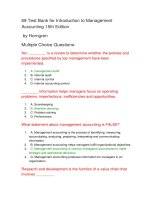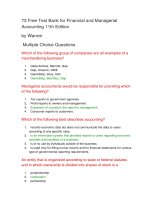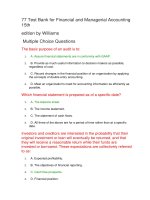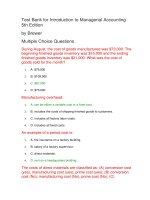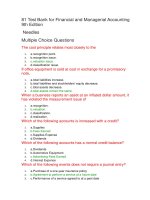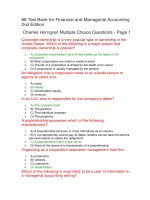77 test bank for financial and managerial accounting 15th
Bạn đang xem bản rút gọn của tài liệu. Xem và tải ngay bản đầy đủ của tài liệu tại đây (94.75 KB, 21 trang )
77 Test Bank for Financial and Managerial Accounting
15th
edition by Williams
Multiple Choice Questions
The basic purpose of an audit is to:
1.
A. Assure financial statements are in conformity with GAAP.
2.
B. Provide as much useful information to decision makers as possible,
regardless of cost.
3.
C. Record changes in the financial position of an organization by applying
the concepts of double entry accounting.
4.
D. Meet an organization's need for accounting information as efficiently as
possible.
Which financial statement is prepared as of a specific date?
1.
A. The balance sheet.
2.
B. The income statement.
3.
C. The statement of cash flows.
4.
D. All three of the above are for a period of time rather than at a specific
date.
Investors and creditors are interested in the probability that their
original investment or loan will eventually be returned, and that
they will receive a reasonable return while their funds are
invested or borrowed. These expectations are collectively referred
to as:
1.
A. Expected profitability.
2.
B. The objectives of financial reporting.
3.
C. Cash flow prospects.
4.
D. Financial position.
The field of accounting may best be described as:
1.
2.
A. Recording the financial transactions of an economic entity.
B. Developing information in conformity with generally accepted accounting
principles.
3.
C. The art of interpreting, measuring, and describing economic activity.
4.
D. Developing the information required for the preparation of income tax
returns.
It is the function of management accounting to perform the
following activities, except:
1.
A. Financial forecasts
2.
B. Cost accounting
3.
C. Internal audits
4.
D. Audited financial statements
Which of the following decision makers is least likely to be among
the users of management accounting reports developed by Sears
Roebuck and Co?
1.
A. The chief executive officer of Sears.
2.
B. The manager of the Automotive Department in a Sears' store.
3.
4.
C. The manager of a mutual fund considering investing in Sears' common
stock.
D. Internal auditors within the Sears organization.
The designation of CPA is given by:
1.
A. Universities.
2.
B. States.
3.
C. The AICPA.
4.
D. The SEC.
A complete set of financial statements for Citywide Company, at
December 31, 2009, would include each of the following, except:
1.
A. Balance sheet as of December 31, 2009.
2.
B. Income statement for the year ended December 31, 2009.
3.
C. Statement of projected cash flows for 2009.
4.
D. Notes containing additional information that is useful in interpreting the
financial statements.
Financial statements are prepared:
1.
A. Only for publicly owned business organizations.
2.
B. For corporations, but not for sole proprietorships or partnerships.
3.
C. Primarily for the benefit of persons outside of the business organization.
4.
D. In either monetary or nonmonetary terms, depending upon the need of
the decision maker.
Which of the following is not a basic function of an accounting
system?
1.
2.
A. To interpret and record the effects of business transactions.
B. To classify the effects of similar transactions in a manner that permits
determination of various totals and subtotals useful to management.
3.
C. To ensure that a business organization will be managed profitably.
4.
D. To summarize and communicate information to decision makers.
Which financial statement is primarily concerned with reporting
the financial position of a business at a particular time?
1.
A. The balance sheet.
2.
B. The income statement.
3.
C. The statement of cash flows.
4.
D. All three statements are concerned with the financial position of a
business at a particular time.
Which of the following is not characteristic of financial
accounting?
1.
A. Information used in financial statements is prepared in conformity with
generally accepted accounting principles.
2.
B. The information is confidential and is intended for use only by company
management.
3.
4.
C. The information is used in a wide variety of business decisions.
D. The information is developed primarily by "private accountants" that is,
accountants employed by business organizations.
The measures used by an organization to provide reasonable
assurance that the organization produces reliable financial
reports, complies with applicable laws and regulations, and
conducts its operations in an efficient and effective manner are
collectively referred to as:
1.
A. Generally accepted accounting principles.
2.
B. Financial accounting standards.
3.
C. Securities and exchange regulations.
4.
D. The internal control structure.
Which of the following would not be considered a user of financial
information?
1.
A. A large pension fund
2.
B. A real estate investor
3.
C. Company management
4.
D. All the above are considered interested in financial information.
Although accounting information is used by a wide variety of
external parties, financial reporting is primarily directed toward the
information needs of:
1.
A. Investors and creditors.
2.
B. Government agencies such as the Internal Revenue Service.
3.
C. Customers.
4.
D. Trade associations and labor unions.
In comparison with a financial statement prepared in conformity
with generally accepted accounting principles, a management
accounting report is more likely to:
1.
2.
A. Be used by decision makers outside of the business organization.
B. Focus upon the operation results of the most recently completed
accounting period.
3.
C. View the entire organization as the reporting entity.
4.
D. Be tailored to the specific needs of an individual decision maker.
Which of the following is generally not considered an external
user of accounting information?
1.
A. Stockholders of a corporation.
2.
B. Bank lending officers.
3.
C. Financial analysts.
4.
D. Factory managers.
Which of the following is considered a return "on" investment?
1.
A. Dividends.
2.
B. Repayment of a loan.
3.
C. Both of the above.
4.
D. None of the above.
The basic purpose of bookkeeping is to:
1.
2.
A. Provide financial information about an economic entity.
B. Develop the types of information best-suited to specific managerial
decisions.
3.
C. Record the financial transactions of an economic entity.
4.
D. Determine the taxable income of individuals and business entities.
Financial accounting information is
1.
A. Designed to assist investors and creditors
2.
B. Used by managers and in income tax returns
3.
C. Called "general-purpose" accounting information
4.
D. All of the above
The FASB takes on a responsibility to do the following, except:
1.
A. Set the objectives of financial reporting.
2.
B. Describe the elements of financial statements.
3.
C. Judge disputes between management and the CPA.
4.
D. Determine the criteria for deciding what information to include in financial
statements.
The Sarbanes-Oxley Act of 2002 created:
1.
A. The Security and Exchange Commission
2.
B. The Financial Accounting Standards Board
3.
C. The Public Company Accounting Oversight Board
4.
D. The Income Tax Return Overview Board
Which of the following is a characteristic of financial accounting
information?
1.
A. It's preparation requires judgment.
2.
B. It is more about the future than it is about the past.
3.
C. None of it is based on estimates, assumptions, and judgments.
4.
D. Notes and explanations from management are not included.
Investors may be described as:
1.
A. Individuals and enterprises that have provided credit to a reporting entity.
2.
B. Individuals and enterprises that own a reporting entity business.
3.
C. Anyone that has an interest in the results of the operations of the
reporting entity.
4.
D. Those whose primary economic activity consists of buying and selling
stocks and bonds.
Information is cost effective when:
1.
2.
A. The information aids management in controlling costs.
B. The information is based upon historical costs, rather than upon
estimated market values.
3.
C. The value of the information exceeds the cost of producing it.
4.
D. The information is generated by a computer based accounting system.
The principal difference between management accounting and
financial accounting is that financial accounting information is:
1.
A. Prepared by managers.
2.
B. Intended primarily for use by decision makers outside the business
organization.
3.
C. Prepared in accordance with a set of accounting principles developed by
the Institute of Certified Management Accountants.
4.
D. Oriented toward measuring solvency rather than profitability.
The objectives of financial reporting are to provide information
1.
A. that is useful in assessing cash flow prospects
2.
B. about claims to enterprise resources
3.
C. that is useful in investment and credit decisions
4.
D. all of the above
Financial statements may be prepared for
1.
A. One year
2.
B. Less than one year
3.
C. Either A or B
4.
D. Neither A or B. Financial statements can only be prepared on a monthly
basis.
The financial statements of a business entity:
1.
A. Include the balance sheet, income statement, and income tax return.
2.
B. Provide information about the cash flow prospects of the company.
3.
C. Are the first step in the accounting process.
4.
D. Are prepared for a fee by the Financial Accounting Standards Board.
The general purpose financial statements prepared annually by a
corporation would not include the:
1.
A. Balance sheet.
2.
B. Income tax return.
3.
C. Income statement.
4.
D. Statement of cash flows.
Which of the following events is not a transaction that would be
recorded in a company's accounting records?
1.
A. The purchase of equipment for cash.
2.
B. The purchase of equipment on account.
3.
C. The investment of additional cash in the business by the owner.
4.
D. The death of a key executive.
Financial statements are designed primarily to:
1.
A. Provide managers with detailed information tailored to the managers'
specific information needs.
2.
B. Provide people outside the business organization with information about
the company's financial position and operating results.
3.
C. Report to the Internal Revenue Service the company's taxable income.
4.
D. Indicate to investors in a particular company the current market values of
their investments.
Which organization best serves the professional needs of a
CPA?
1.
A. FASB.
2.
B. AICPA.
3.
C. SEC.
4.
D. AAA.
The accounting systems of most business organizations:
1.
A. Are tailored to meet the organization's needs for accounting information
and the resources available for operating the system.
2.
B. Are similar in design to the journals, ledgers, and worksheets illustrated
in this text.
3.
C. Utilize data bases, rather than ledger accounts.
4.
D. Are designed by the CPA firm that performs the annual financial audit.
A strong internal control structure:
1.
A. Contributes to the accuracy and reliability of the accounting records.
2.
B. Will prevent a business from operating at a loss.
3.
C. Assures that a business will remain solvent.
4.
D. Will prevent fraud, theft, and embezzlement.
Generally accepted accounting principles
1.
A. Originate from a combination of tradition, experience and official decree
2.
B. May change over time
3.
C. Both A & B
4.
D. Neither A nor B
77 Free Test Bank for Financial and Managerial
Accounting 15th edition by Williams Multiple Choice
Questions - Page 2
Of the following objectives of financial reporting, which is the most
specific?
1.
A. Provide information useful in assessing amount, timing, and uncertainty
of future cash flows.
2.
B. Provide information useful in making investment and credit decisions.
3.
C. Provide information about economic resources, claims to resources, and
changes in resources and claims.
4.
D. Provide information useful to help the enterprise achieve its goals,
objectives, and mission.
Which of the following is not an objective of generally accepted
accounting principles?
1.
A. To minimize the amount of income taxes owed.
2.
B. To ensure that both preparers and users of financial statements
understand the concepts and assumptions used in presenting information
within these statements.
3.
C. To enhance the relevance and reliability of information contained in
financial statements.
4.
D. To increase the comparability of financial statements prepared by
different companies.
Which of the following is generally not considered one of the
general purpose financial statements issued by a corporation?
1.
A. Income statement forecast for the coming year.
2.
B. Balance sheet.
3.
C. Statement of financial position.
4.
D. Statement of cash flows.
Which of the following are important factors in ensuring the
integrity of accounting information?
1.
A. Institutional factors, such as standards for preparing information.
2.
B. Professional organizations, such as the American Institute of CPAs.
3.
C. Competence, judgment, and ethical behavior of individual accountants.
4.
D. All of the above.
Which of the following is true?
1.
A. The existence of generally accepted accounting principles (GAAP)
virtually eliminates the need for professional judgment except in very
unusual circumstances.
2.
B. Federal securities laws regarding the issuance of misleading financial
statements apply not only to the independent auditors, but to management
of the company as well.
3.
C. Attaining a passing score on the part of the Uniform CPA Examination
that covers professional ethics is evidence of integrity and commitment to
ethical conduct.
4.
D. A professional accountant should resign his position rather than become
involved in the distribution of financial statements indicating insolvency.
Characteristics of internal accounting information include all of the
following except:
1.
A. It is audited by a CPA.
2.
B. It must be timely.
3.
C. It is oriented toward the future.
4.
D. It measures efficiency and effectiveness.
The objectives of an accounting system include all of the following
except:
1.
A. Interpret and record the effects of business transactions.
2.
B. Classify the effects of transactions to facilitate the preparation of reports.
3.
C. Summarize and communicate information to decision makers.
4.
D. Dictate the specific types of business transactions that the enterprise
may engage in.
The code of ethics of the American Institute of Certified Public
Accountants includes requirements in which of the following
areas?
1.
A. The Public Interest.
2.
B. Objectivity.
3.
C. Independence.
4.
D. All of the above.
The basic purpose of audited financial statements is to:
1.
A. Provide the reporting company with assurance that all assets are
protected from theft or embezzlement.
2.
B. Prepare financial statements for companies that do not have their own
accounting departments.
3.
C. Provide users of the financial statements with assurance that the
statements are reliable and are presented in conformity with generally
accepted accounting principles.
4.
D. Provide both the reporting company and the users of the statements with
a written guarantee that the statements are error-free.
The primary function of external auditors is to:
1.
2.
A. Express an opinion on the fairness and reliability of the company's
financial statements.
B. Determine the accuracy of the management reports.
3.
C. Evaluate the efficiency of operations and the degree of compliance with
management's policies in all departments within a large organization.
4.
D. Determine that financial statements and all special reports to
management are prepared in conformity with generally accepted accounting
principles.
Which of the following does not describe accounting?
1.
A. It is commonly referred to as the language of business.
2.
B. It is an end rather than a means to an end.
3.
C. It is useful for decision-making.
4.
D. It is used by businesses, governments, non-profit organizations, and
individuals.
The auditor's report on the published financial statements of a
large corporation should be viewed as:
1.
A. The opinion of independent experts as to the overall fairness of the
statements.
2.
B. The opinion of the corporation's chief accountant as to the overall
fairness of the statements.
3.
C. A guarantee by a firm of certified public accountants that the statements
are accurate.
4.
D. A guarantee by the Financial Statements Insurance Board that the
statements do not overstate assets or net income.
Which of the following is not considered a return "of" investment?
1.
A. Dividends.
2.
B. Repayment of a loan.
3.
C. Both of the above.
4.
D. None of the above.
The set of standards, assumptions, and concepts that form the
"ground rules" for financial reporting in the United States is
termed:
1.
A. The conceptual framework.
2.
B. Generally accepted accounting principles.
3.
C. Statements of Financial Accounting Concepts.
4.
D. American standards for certified public accountants.
Which of the following has the least impact upon the reliability of
financial statements issued by publicly owned corporations?
1.
A. Federal securities laws.
2.
B. Professional judgment of the accountants who prepare the financial
statements.
3.
C. Audits of the financial statements by the Internal Revenue Service.
4.
D. Competence and integrity of the CPAs who perform audits.
Internal users of financial accounting information include all of the
following except:
1.
A. Investors.
2.
B. Managers.
3.
C. Chief Financial Officer.
4.
D. Chief Executive Officer.
The body created by the Sarbanes Oxley Act and charged with
oversight of the accounting profession is the:
1.
A. Public Company Accounting Oversight Board
2.
B. Auditing Standards Board
3.
C. International Accounting Standards Board
4.
D. Security and Exchange Commission
The work of accountants practicing in public accounting may best
be described as:
1.
A. Providing various types of accounting services to a wide variety of
clients.
2.
B. Preparing income tax returns for individuals and small businesses.
3.
C. Developing and interpreting information tailored to the needs of business
managers.
4.
D. Helping governmental agencies carry out their various regulatory
responsibilities.
Generally accepted accounting principles are the "ground rules"
used in the preparation of:
1.
A. Income tax returns.
2.
B. All accounting reports.
3.
C. Reports to federal and state regulatory agencies.
4.
D. Financial statements.
Which of the following are considered "external" users of financial
statements?
1.
A. Owners.
2.
B. Creditors.
3.
C. Labor unions.
4.
D. All three are external users.
Which of the following is not a user of internal accounting
information?
1.
A. Store manager.
2.
B. Chief executive officer.
3.
C. Creditor.
4.
D. Chief financial officer.
Financial accounting information is characterized by all of the
following except:
1.
A. It is historical in nature.
2.
B. It results from inexact and approximate measures.
3.
C. It is factual, so it does not require judgment to prepare.
4.
D. It is enhanced by management's explanation.
Suppose a number of your friends have organized a company to
develop and sell a new software product. They have asked you to
loan them $8,000 to help get the company started, and have
promised to repay your $8,000 plus 10% interest in one year. Of
the following, which amount may be described as the return on
your investment?
1.
A. $8,000
2.
B. $800.
3.
C. $8,800
4.
D. some other amount.
Establishing international accounting standards is the
responsibility of
1.
A. AICPA
2.
B. IASB
3.
C. SEC
4.
D. AAA
Overseeing a company's affairs to ensure that the company is
managed with the best interest of shareholders in mind is called:
1.
A. Internal control
2.
B. Financial integrity
3.
C. Corporate governance
4.
D. The audit function
An accounting principle must receive substantial authoritative
support to qualify as generally accepted. Among the
organizations and agencies that have been influential in the
development of generally accepted accounting principles, which
of the following has provided the most influential leadership?
1.
A. Internal Revenue Service.
2.
B. Institute of Management Accountants.
3.
C. Financial Accounting Standards Board.
4.
D. New York Stock Exchange.
The Financial Accounting Standards Board is:
1.
A. Responsible for the review and audit of federal income tax returns.
2.
B. Primarily concerned with the preparation of the annual federal budget.
3.
C. A private group that conducts research and issues Statements that
represent authoritative expressions of generally accepted accounting
principles.
4.
D. A government agency with legal authority to approve or disapprove the
financial statements of corporations that sell their securities to the public.
In the phrase "generally accepted accounting principles," the
words accounting principles refers to:
1.
A. The standards, assumptions, and concepts that serve as "ground rules"
for financial reporting.
2.
B. Ethical standards that prohibit fraudulent or misleading financial
reporting.
3.
4.
C. The steps in the accounting cycle.
D. The accounting practices authorized by the Financial Accounting
Standards Board (FASB).
Statements of Financial Accounting Standards are developed by:
1.
A. The Financial Accounting Standards Board.
2.
B. Certified public accountants.
3.
C. The Securities and Exchange Commission.
4.
D. The Internal Revenue Service.
The accounting standards and concepts used in the preparation
of financial statements are called:
1.
A. Certified principles of accounting (CPA).
2.
B. Generally accepted accounting principles (GAAP).
3.
C. Federal accounting standards and bylaws (FASB).
4.
D. Standards enforcing consistency (SEC).
Which of the following is not recognized as a source of generally
accepted accounting principles?
1.
A. Widespread and long-term use of a particular practice.
2.
B. The Financial Accounting Standards Board (FASB).
3.
C. The American Institute of Certified Public Accountants (AICPA).
4.
D. None of the above. Generally accepted accounting principles may arise
from each of these sources.
The principal function of CPAs is to:
1.
A. Audit income tax returns to determine if taxpayers have underpaid their
income taxes.
2.
B. Conduct audits to determine whether the employees of a business are
performing their jobs honestly and efficiently.
3.
4.
C. Advise individual investors on stock market investments.
D. Perform audits to determine the fairness and reliability of a company's
financial statements.
The basic purpose of generally accepted accounting principles is
to:
1.
A. Minimize the possibility of a business becoming insolvent.
2.
B. Provide a framework for financial reporting that is understood by both the
preparers and the users of financial statements.
3.
C. Ensure that financial statements include the type of information that is
best suited to every type of business decision.
4.
D. Eliminate the need for professional judgment in preparing financial
statements.
Objectives of financial reporting to external investors and
creditors include preparing information about all of the following
except:
1.
A. Information used to determine which products to produce.
2.
B. Information about economic resources, claims to those resources, and
changes in both resources and claims.
3.
C. Information that is useful in assessing the amount, timing, and
uncertainty of future cash flows.
4.
D. Information that is useful in making investment and credit decisions.
Audits of financial statements are performed by:
1.
A. The controller of the reporting company.
2.
B. The Financial Accounting Standards Board (FASB).
3.
C. The management of the reporting company.
4.
D. Independent certified public accountants (CPAs).
To understand and use accounting information in making
economic decisions, you must understand:
1.
A. The nature of economic activities that accounting information describes.
2.
B. The assumptions and measurement techniques involved in developing
accounting information.
3.
C. Which information is relevant for a particular type of decision that is
being made.
4.
D. All of the above.
All of the following are characteristics of management accounting,
except:
1.
A. Reports are used primarily by insiders rather than by persons outside of
the business entity.
2.
B. Its purpose is to assist managers in planning and controlling business
operations.
3.
C. Information must be developed in conformity with generally accepted
accounting principles or with income tax regulations.
4.
D. Information may be tailored to assist in specific managerial decisions.
Generally accepted accounting principles are intended to assist
accountants in preparing financial statements that:
1.
A. Are relevant, reliable, comparable, and understandable.
2.
B. Show the business to be both solvent and profitable.
3.
C. Comply with all income tax rules and regulations.
4.
D. Are ideally suited to the specific needs of each user of the financial
statements.
Management accountants primarily are concerned with
developing information:
1.
2.
A. For use in income tax returns.
B. Suited to the needs of stockholders, creditors, and other external
decision makers.
3.
C. In conformity with generally accepted accounting principles.
4.
D. Suited to the needs of decision makers within the organization.
The best definition of an accounting system is:
1.
2.
A. Journals, ledgers, and worksheets.
B. Manual or computer-based records used in developing information about
an entity for use by managers and also persons outside the organization.
3.
C. The personnel, procedures, devices, and records used by an entity to
develop accounting information and communicate this information to
decision makers.
4.
D. The concepts, principles, and standards specifying the information which
should be included in financial statements, and how that information should
be presented.
In the phrase "generally accepted accounting principles," the
words generally accepted mean that the principles:
1.
2.
A. Have been adopted by Congress or approved by the voters in a general
election.
B. Are acceptable to the Internal Revenue Service.
3.
C. Are understood and observed by all the participants in the financial
reporting process.
4.
D. Have been approved by a majority of the members of the Financial
Accounting Standards Board.
